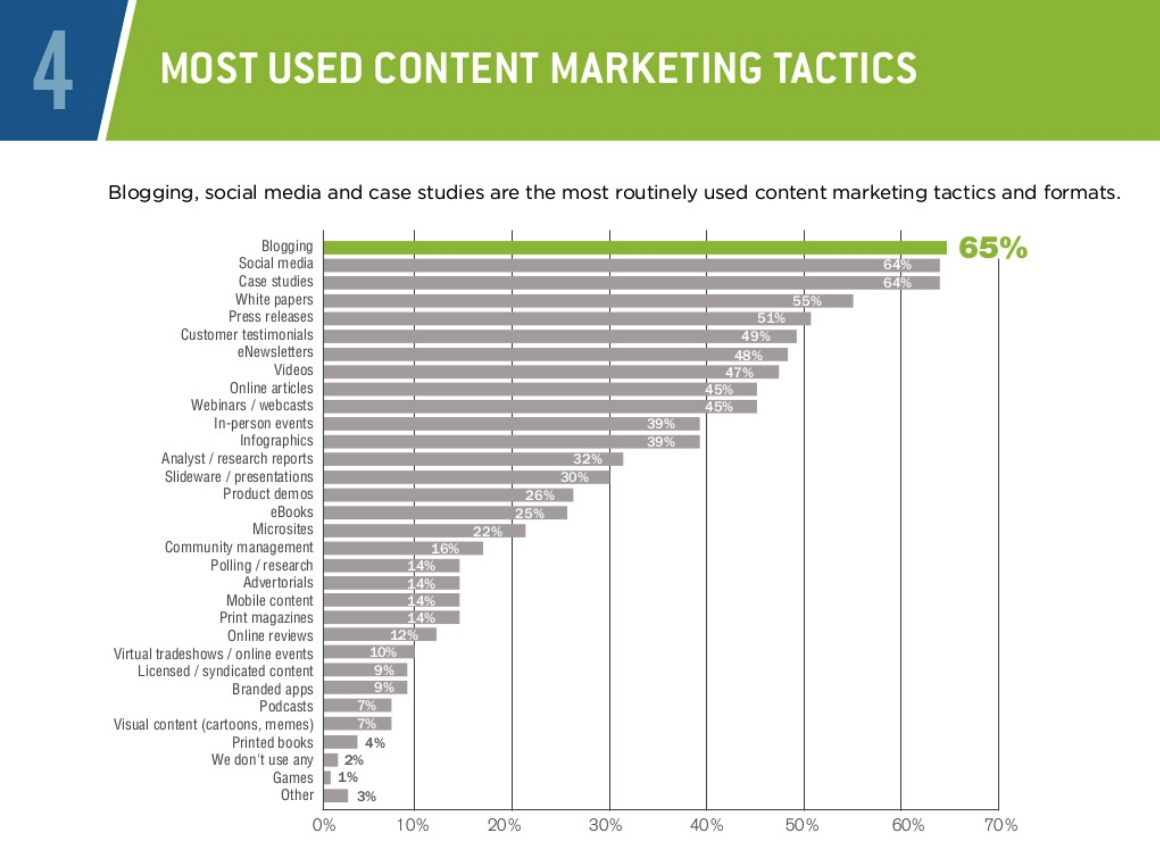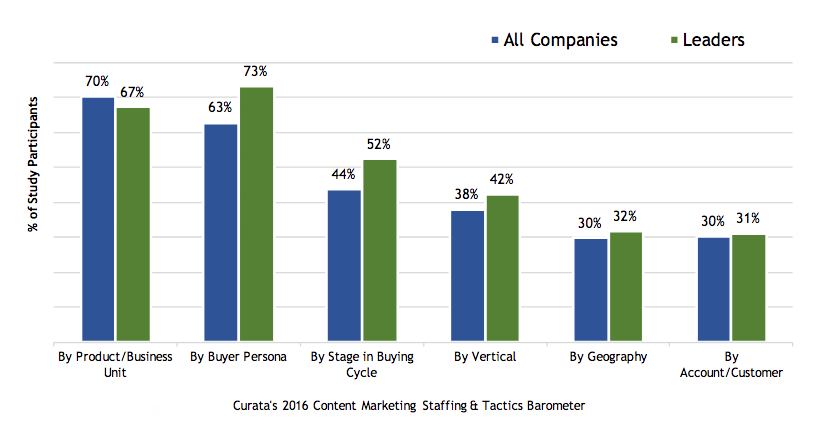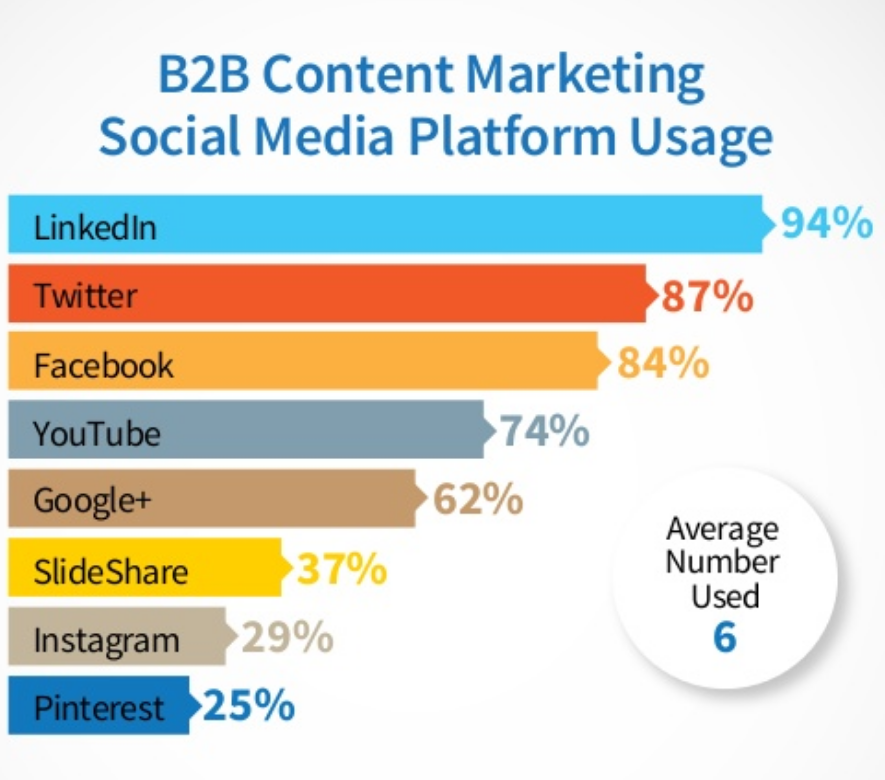With 2018 starting, now is the time to look ahead and start planning for the lap around the sun.
And as the content marketing landscape continues to rapidly evolve, it makes sense to look to research to identify trends and patterns that can help guide your strategy. That’s why we’ve gathered 54 content marketing stats all in one place – so you can start thinking about how this data will inform your plans for 2018.
Let’s dive in and explore these stats to get a firm grasp on what’s new within this realm.
Blogging Statistics
#1) Long-form blog posts generate 9x more leads than short-form blog posts. – Curata
The takeaway: Long-form content tends to be more educational and in-depth, thus increasing the amount of value delivered to the reader. In turn, this builds trust with the audience.
Creating longer blog posts often means devoting more attention to high-quality content that translates into eventual sales.
#2) Only 55% of bloggers update old posts. Those who do are 74% more likely to get strong results – Orbit Media
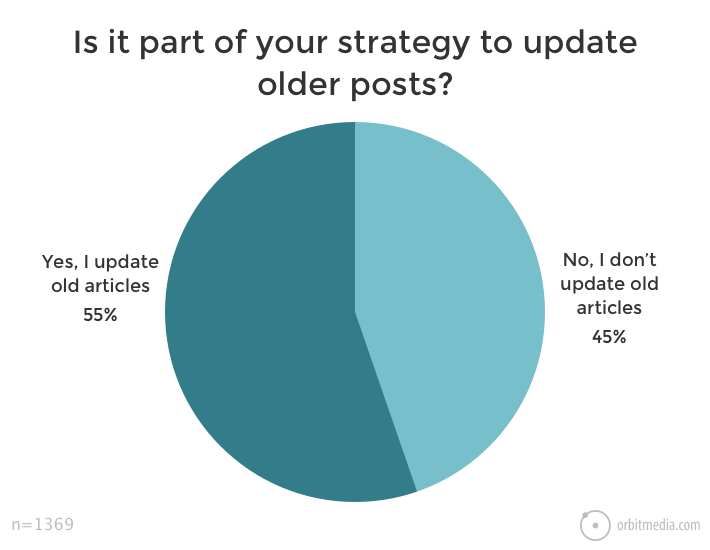
Takeaway: Blog posts are not like a fine wine, they don’t get better with age. Go back and add content upgrades to the posts that are working, expand sections with new information, and make sure your content is evergreen.
If your popular content starts slipping down the ranks, a simple update could increase organic traffic 402% month-over-month, as detailed in step #3 of this tutorial.
In the eyes of Google, newer content is more likely to be relevant than a post from years back, so sometimes updating a post can be as good as writing a new one.
In fact, this is part of the SEO strategy we have used to steadily grow our organic traffic over the last 12 months here at SnapApp:
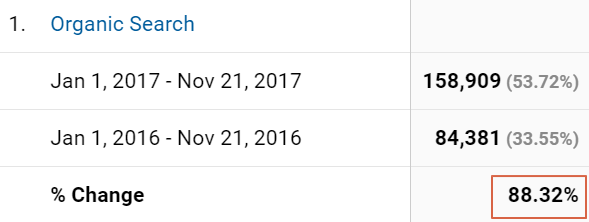
#3) 76% of B2B marketers blog, and 73% publish case studies – Content Marketing Institute
Takeaway: Blogging is still one of the most widely-used content marketing strategies, and for a good reason; blogging builds links (and authority), gives you a platform promote your product/service, and provides a vehicle to educate prospects.
Case studies allow businesses to use relatable business stories to move prospects towards the end of the buyer journey. If a buyer is on the fence, seeing the success of a similar business in the same industry can help make the choice easier.
#4) The top three content marketing tactics are blogging (65%), social media (64%), and case studies (64%) – LinkedIn Technology Marketing Community
Takeaway: Blogging and social media are reportedly the two most successful marketing tactics, as proven in Regalix’s State of B2B Marketing 2016, and practically every study you’ll find.
The two tactics address different stages of the buyer journey; blogging is great for lead generation because users can discover content through search, and social media is best for building a relationship with leads and directing them back to your content over and over again.
#5) 45% of marketers say blogging is their #1 most important content strategy. – Social Media Examiner
Takeaway: Blogging allows marketers to create educational material, to collect audience information via opt-ins, and to improve SEO efforts–all at the same time.
#6) The average blog post is now 1,142 words (up 41% since 2014) – Orbit Media

Takeaway: In the early days of blogging, 500 word posts were enough to get you ranking for a keyword. Those days are long gone, and now the first page of Google is wildly competitive. With so much content to organize, Google looks at word count as an indicator of depth and quality.
While typical post length has steadily ticked up over the years, the length of a #1 ranking post is much higher. A study by SerpIQ found that top ranking content is usually just over 2,400 words. This could be tied to the fact that longer blog posts get more backlinks.
#7) The average reader only spends 37 seconds reading an article or blog post. – NewsCred Insights
Takeaway: Online attention spans are shorter than ever–so content needs to be snackable and easy to read. With an average read time of less than one minute, more content writers are realizing the importance of structuring easily scannable articles and using bolding, bullet points, and italics to make important themes stand out from the page.
Content Promotion Statistics
#8) Paid content promotion is up 5x since 2014 – Orbit Media
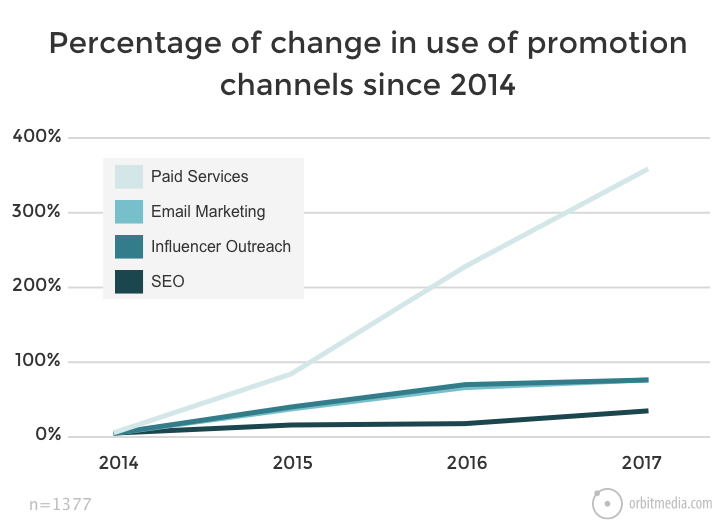
Takeaway: SEO, email marketing and influencer outreach remain the three most common ways for bloggers to get traffic to their site, but paid promotion has skyrocketed almost 400% since 2014.
The most ubiquitous type of paid promotion is Google AdWords, which reaches over a billion people. A report by Google shows that businesses typically see 200% ROI from AdWords.
Since 98% of searchers choose a business on page 1 of Google, chances are you need to grab some search engine real estate around the keywords related to your business.
#9) The top three paid advertising methods used by B2B marketers are SEM (66%); print or other offline promotion (57%), and traditional online banner ads (55%) – Content Marketing Institute/MarketingProfs

Takeaway: Content marketing shines as a way to drive organic traffic, but sometimes relying on Google rankings isn’t good enough. Two-thirds of marketers use PPC ads to get eyes on their landing pages and blogs.
The same study reports that SEM is widely considered to be effective (54%), which is more than can be said for banner ads (27%) and offline promotion (24%) — it could be time to cut the budget for your antiquated banners and magazines, and go all-in on PPC. Or, at least put it to the test 🙂
#10) Mobile will account for 72% of US digital ad spend by 2019. – eMarketer
Takeaway: As mobile continue to rise as the preferred medium for users, marketers are increasing their advertising spends accordingly.
We know that there mobile searches outpaced desktop back in 2014, so it makes sense that more and more marketing teams are putting an intense focus on mobile ads.
#11) 42% of B2B marketers say they’re effective at content marketing – Content Marketing Institute
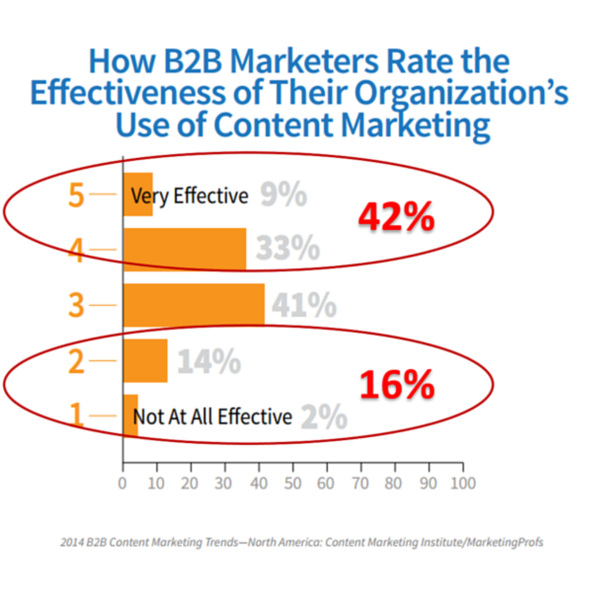
Takeaway: Businesses are doubling down on content marketing. Better educational resources, solid marketing plans, and dedicated content teams are making businesses more effective at content marketing.
As Content Marketing Institute and Marketing Profs say, the industry is still in its formative years — it’s a vital time to focus your time and money on a proven strategy, and cut back on anything not moving the needle.
As the graph above shows, there is a HUGE opportunity gap in content marketing.
#12) 81%+ of marketers found that increased traffic occurred with as little as 6 hours per week invested in social media marketing. – Social Media Examiner
Takeaway: Social media marketing continues to help content marketers extend the reach and shareability of their content and campaigns, and this will continue next year.
It may be time to consider how you can better participate on these channels and get the most out of the opportunities presented by mediums like Twitter, LinkedIn, Instagram, and Facebook (to name a few.)
#13) Infographics are liked and shared on social media 3X more than other any other type of content. – MassPlanner
Takeaway: The shareability of infographics continue make them an important piece of the content marketing puzzle. Add interactivity, and they become even more engaging for the reader.
Content ROI Statistics
#14) Content marketing costs 62% less than traditional marketing and generates about 3 times as many leads – DemandMetric

Takeaway: Traditional marketing channels like TV adverts, direct mail and telemarketing all requires a lot of money to get started. And, it’s nowhere near as targeted as content marketing.
With content marketing, you can place an ad for your product in an article that ranks for a very specific, high-converting keyword. TV ads aren’t as relevant to each viewer, so the conversion rate is much lower, especially for niche products.
The benefits of content marketing compound over time as your pages gain links and authority. Unlike hiring a team of telemarketers, the content engine, once in motion, will bring in leads on autopilot.
#15) 74% of companies indicate content marketing is increasing their marketing teams’ lead quality and quantity – Curata
Takeaway: The point of content marketing is to generate sales-ready leads, right? A staggering 74% of companies found that both lead quantity and lead quality improved thanks to an informed content strategy.
This means the marketing team’s efforts are making the sales team’s jobs easier too because they aren’t wasting their time with low quality, unqualified leads.
Check out this article to learn more about better aligning your sales and marketing teams.
#16) 67% of the typical B2B buyer’s journey is now done digitally, and 9 out of 10 B2B buyers say online content has a moderate to major effect on their purchasing decisions. – Lenati
Takeaway: The modern B2B customer is a digital one–and content plays a large part in the buyer’s journey. This is likely part of the reason companies are planning to create more high-quality content in the year to come.
It makes sense to tailor marketing assets to the needs and wants of the buyer.
#17) Only 8% of marketers consider themselves “very successful” or “extremely successful” at tracking content marketing ROI – LinkedIn Technology Marketing Community
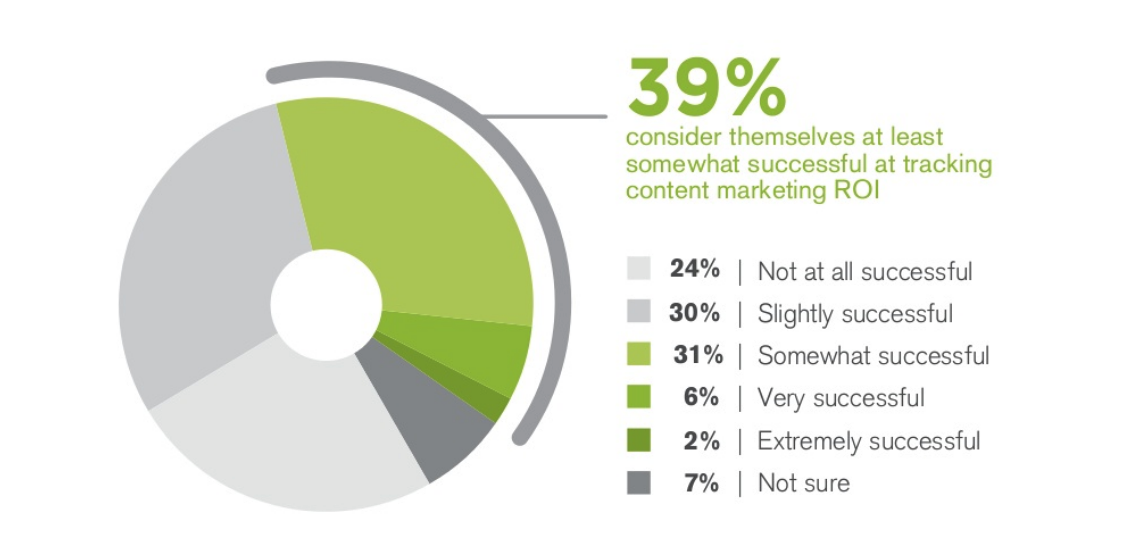
Takeaway: Without the right tools, tracking the ROI of your content can be nearly impossible. You can see your most viewed pages or most liked tweets, but tracking the entire journey from the first touch to the closing sale requires a specific marketing technology stack.
You’re going to need to establish KPIS, configure analytics, and build reports that map metrics back to the bottom line.
#18) 65% of B2B marketers struggle to define what content is effective and what isn’t – Content Marketing Institute
Takeaway: If you had a blueprint for what content is and isn’t working, you’d waste less time than 65% of businesses who are off experimenting with unproven methods.
For smaller sites, determining your most effective content could be as simple as looking at the top 10 organically ranked posts on your site, and then checking how many visitors go on to subscribe or sign up.
You can use something like Google Analytics’ User Flow report to do exactly that.
Content Strategy Statistics
#19) 93% of B2B marketers use content marketing – Content Marketing Institute

Takeaway: Over half of the marketers in the small section of the pie that don’t currently use content marketing are launching content in the next 12 months, and just 4% said they stopped because it wasn’t working.
Almost every business that has tried content marketing, continues to use it. If you don’t have a content plan for the future, it’s time to make one.
#20) Seventy two percent of marketers have a content strategy in place. Thirty percent have a documented strategy; 42 a non-documented strategy – LinkedIn Technology Marketing Community
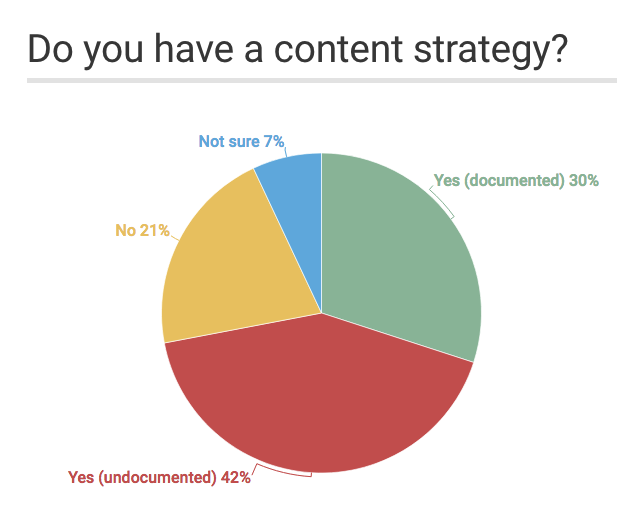
Takeaway: Marketers with a content strategy report better results, fewer challenges, and are more likely allocate a bigger budget for content marketing. Why? Because content marketing works, and more businesses are starting to realize that every day.
If you can get that strategy documented, even better. Use documented business processes to ensure consistency and scalability.
#21) Sixty-three percent of marketers create content by buyer persona; 38 percent by vertical; 30 percent by geography; and 30 percent by account or customer – Curata
Takeaway: Buyer personas help marketers create content to address the pain points of specific segments. In turn, this makes for higher conversion rates because the marketer truly understands the needs of the reader.
MarketingSherpa found using personas increases revenue by 171%.
Targeting by vertical, geography, and lifecycle stage is also common, but most personas actually take these factors into consideration too, giving marketers a vivid picture of their audience. Get started by creating your own today.
#22) 78% of B2B buyers use case studies when researching purchases – DemandGen
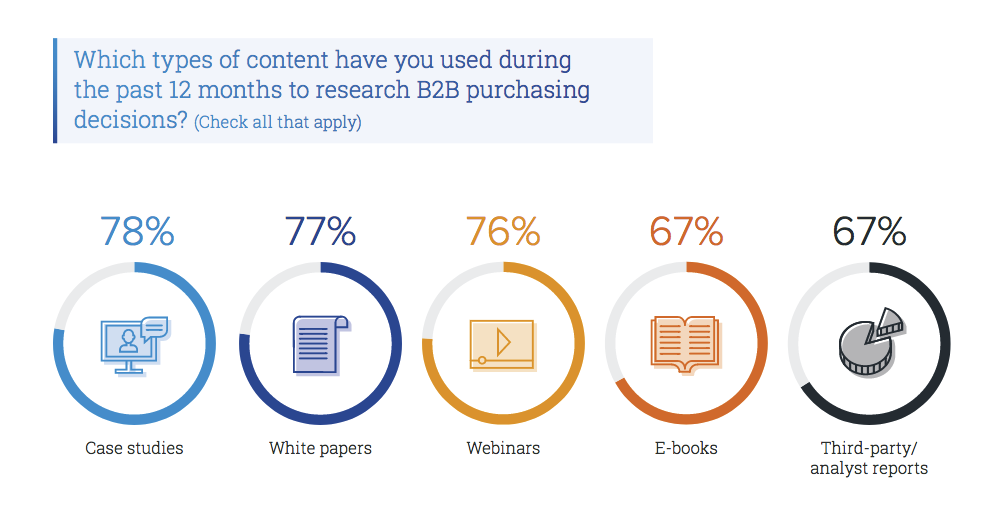
Takeaway: The most tangible way to link your business to a buyer’s need is to show the awesome results similar companies get when they choose your products or services.
As we learned earlier, case studies are one of the most effective content types for this. In fact, DemandGen shows that buyers trust case studies even more than third-party reports.
Check out some of our customer case studies for inspiration on writing your own.
#23) B2B buyers are most likely to share their name and email address in exchange for webinars (79%), white papers (76%), analyst reports (66%), and ebooks (63%) – DemandGen
Takeaway: In content marketing, perceived value is a huge conversion factor. Audiences are used to accessing blog posts without sharing their email address, but something like a book or a white paper feels more valuable — like something they’d pay for in real life.
Turn your blog post series into an ebook, and experiment with how much personal information you can get away with collecting in the form before conversion rate plummets. For example, HubSpot collects eight fields in exchange for an ebook, while some companies only require an email address.
#24) 60% of B2B content marketers say producing engaging content is their biggest challenge – Content Marketing Institute/MarketingProfs
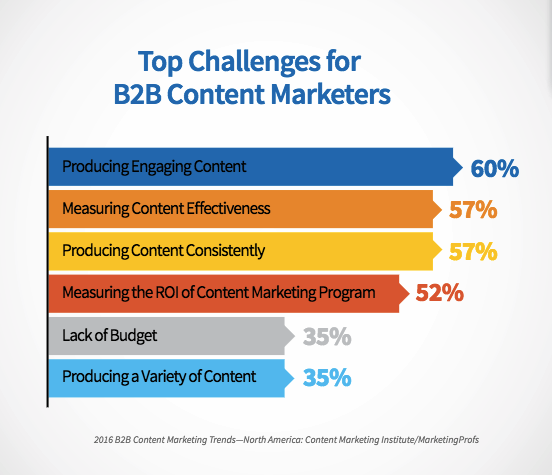
Takeaway: In a world flooded with content, the trick to upping conversions isn’t more content, it’s content that better engages the reader. Keeping a reader hooked the whole way through a blog post or a video makes it easier to bring them round to your narrative or way of thinking when it comes to the call to action.
Social media might have killed our attention spans, but that just makes it all the more important to repurpose content in a snackable form, or optimize to improve time on page.
#25) The top three goals of content marketing are lead generation (59%), thought leadership/market education (43%), and brand awareness (40%) – LinkedIn Technology Marketing Community
Takeaway: In 2017, 1,440 WordPress posts were published every 60 seconds; that’s up 48% from 2014. Put simply, content marketing is a highly competitive game, and lead generation is the #1 goal.
Most businesses focus on top-of-the-funnel readers rather than existing customers because the only thing to do after you’ve got a high-converting site is to push more and more visitors to it.
Compared to statistics from 2013, marketers now consider brand awareness to be more important than customer acquisition. In an ultra competitive market, it’s time to focus on establishing a recognizable brand.
#26) 57% of B2B buyers have already made their purchase decision before ever speaking to a sales person – CEB Global
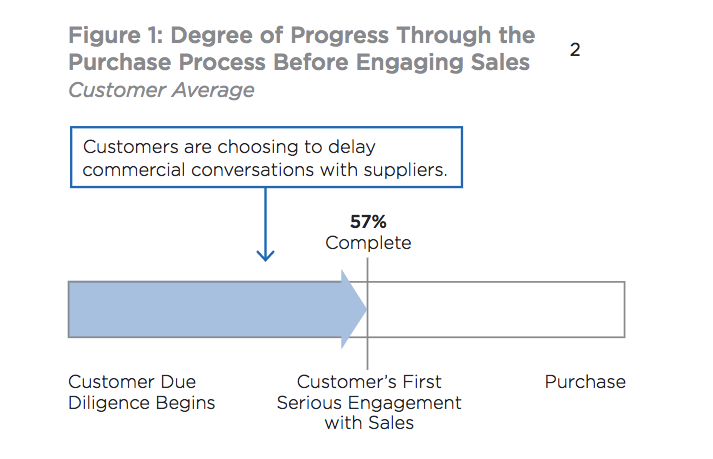
Takeaway: It used to be true that a buyer’s first point of contact before making a purchase decision was a salesperson. That was before the days of content marketing. Now, the internet was saturated with reviews, blog posts, case studies, and tweets.
Today, most buyers make up their mind before ever contacting a salesperson. It’s more important than ever to leverage content to generate more brand awareness at the top of the funnel, educate, and build trust as your audience moves down the funnel.
#27) About 53% of emails are opened on mobile devices. – Campaign Monitor

Takeaway: Email marketing, when part of a larger content marketing strategy, needs to be mobile-friendly in 2017.
As it’s become the preferred method by recipients for reading, be sure you’re using templates that are mobile responsive to best accommodate your audience. This will help boost ROI and extend the readability of the content and campaigns you’ve worked hard to put together.
#28) Emails with personalized subject lines are 26% more likely to be opened. – Experian
Takeaway: Personalization makes content marketing messages feel more customized to the individual. Leverage the data you’ve collected from your audience members and put it to work to drive open rates and increase the effectiveness of your efforts.
Email is one place where personalization is simple and easy to deploy.
#29) 69% of companies report their video marketing budget is increasing. – Ascend2
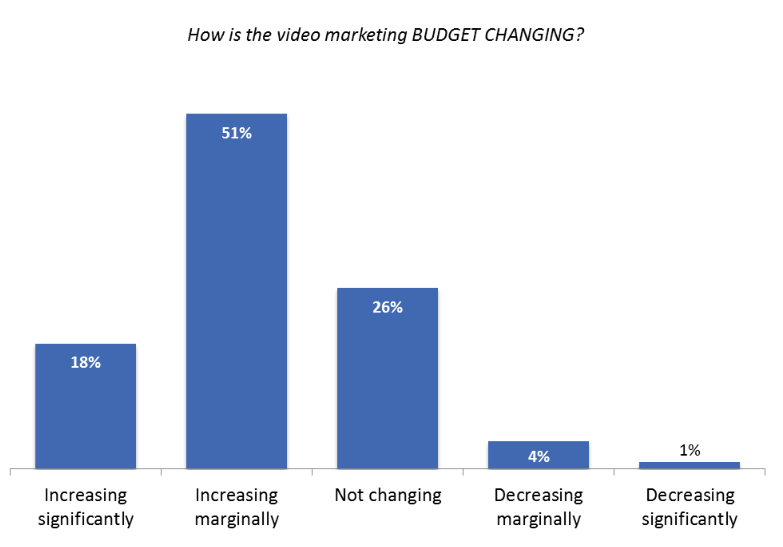
Takeaway: Video is becoming increasingly popular in the content marketing world, and as a result, teams plan to increase their budgets to produce more video content in the coming year.
Thanks to video’s ability to quickly explain ideas and concepts in a visual format, it’s no surprise that this medium is being used more and more.
#30) Only 68% of B2B businesses use landing pages to capture sales lead information for future conversion – Marketing Sherpa
Takeaway: Without a landing page, how are you going to capture your customer’s information and follow up with lead nurturing?
The fact that only 42% of B2B businesses use landing pages is astounding, and indicates that you can get ahead of the crowd by using this tested tactic to convert visitors into leads.
A common problem is that the marketing team are undereducated on landing page creation, or too pressed for time — tools like Unbounce and Instapage make landing pages easy to build and test.
#31) The top 5 most effective social media platforms to engage B2B audiences are LinkedIn (82% effective), Twitter (66%), YouTube (64%), Facebook (41%), and SlideShare (38%) – LinkedIn Technology Marketing Community
Takeaway: LinkedIn is king in the B2B sphere. As a business-oriented social network, LinkedIn is 200% more effective than Facebook, which mainly focuses on personal topics.
Only 12% of respondents said LinkedIn is ineffective, whereas 33% doubted Facebook — that’s 2% higher than Google Plus! With 82% of businesses seeing positive results from LinkedIn, it’s time to learn how to leverage the platform to generate B2B leads, and check out this cool hack.
#32) LinkedIn is 277% more effective for lead generation than Facebook or Twitter – Hubspot
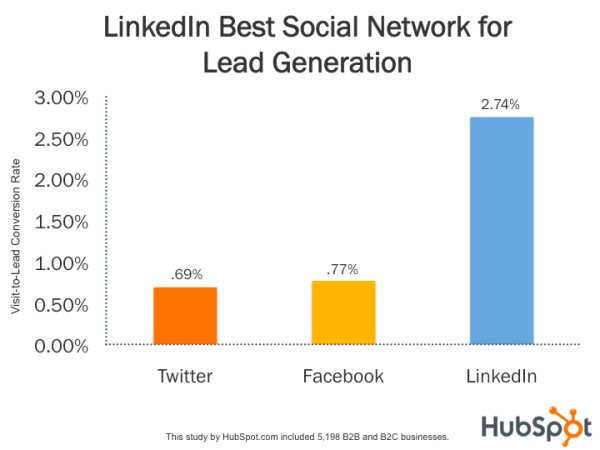
Takeaway: LinkedIn is where businesses live, and where decision-makers go to network. While other social networks like Twitter and Facebook are notorious time sinks, people use LinkedIn more purposefully — to improve their professional relationships and their business.
Prospects are in “business mode” the moment they get onto the site. On average, just 0.98% of traffic to websites from social media converts into leads, but LinkedIn’s 2.74% makes it a platform you should focus on optimizing.
#33) 87% of B2B marketers struggle to produce content that truly engages their buyers – Forrester
Takeaway: By using proven methods like interactive content, you can improve your content’s engagement rate and sell buyers on a deeper narrative that helps them form a connection with your brand.
B2B buying cycles are loooong, so focus on creating consistently useful and engaging content rather than chasing quick-win sales.
#34) The top metrics for B2B content marketing success are sales lead quality (87 percent), sales (84 percent), high conversion rates (82 percent), sales lead quantity (71 percent), website traffic (71 percent), and brand lift (69 percent) and SEO ranking (67 percent) – Content Marketing Institute/MarketingProfs
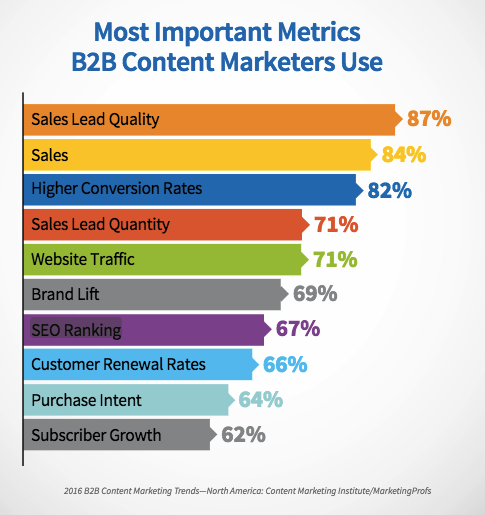
Takeaway: Metrics have different meanings for different companies. This Content Marketing Institute report found that while lead gen was the biggest overall goal, younger companies are more focused on sales, and enterprises value engagement above all.
Lead gen is a safe bet because getting more people into the top of the funnel = more sales.
#35) 4 out of 5 blogs use email newsletters for content marketing – Content Marketing Institute/Marketing Profs

Takeaway: While your blog might see a lot of traffic drifting in and out from organic search, your email newsletter goes out to an engaged core audience who want to hear what you’ve got to say.
This gives you a great advantage when it comes to announcing new products, offers, and resources. Most email marketing automation tools also let you segment your list into different stages of the buying cycle, meaning you can target the right people with the right messaging, and drive sales.
#36) 64% of B2B marketers outsource writing. – TopRankBlog
Takeaway: As marketers strive to publish long-form content more frequently, they’re often turning to outsourced freelance help to accomplish their goals (rather than piling more on the plates of the internal team.) When it comes to writing, this can often be an advantage, as writers can be hired for their speciality or subject matter expertise.
#37) Conversion rates are six times higher (2.9%) for companies and brands using content marketing than those that aren’t (0.5%) – Aberdeen Group

Takeaway: Familiarizing an audience with your brand and your product is a slow process. That’s why Nike plasters its logo everywhere even though it’s one of the most recognizable and memorable brands in the world.
Keeping your company top of mind is the challenge, and content gives you an excuse to promote it regularly while providing useful material. Content builds both familiarity and trust, which are proven to boost conversions.
#38) 95% of B2B buyers consider content as trustworthy when evaluating a company and its offerings – DemandGen
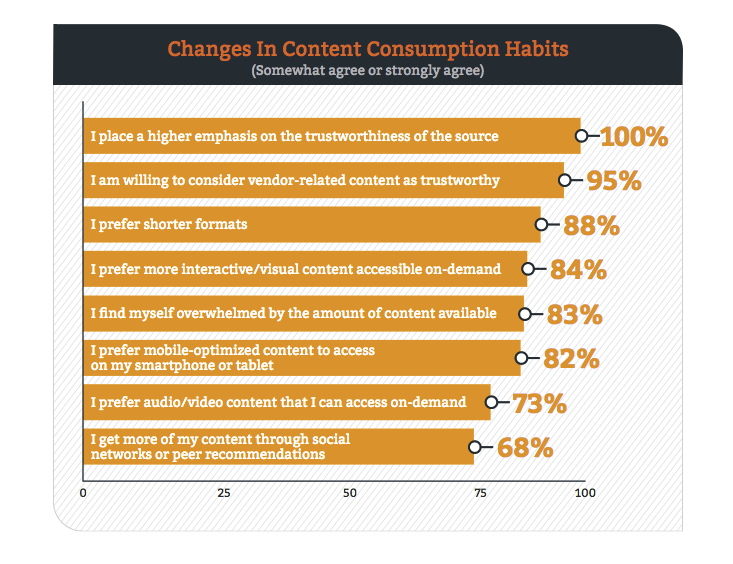
Takeaway: Content isn’t just a straight-up advertisement; the whole point is to provide a useful resource for readers. When you’re known for helping people without charging them, you win the trust of the prospect.
#39) 48% of marketers create content for 3-5 customer purchasing stages – LinkedIn Technology Marketing Community
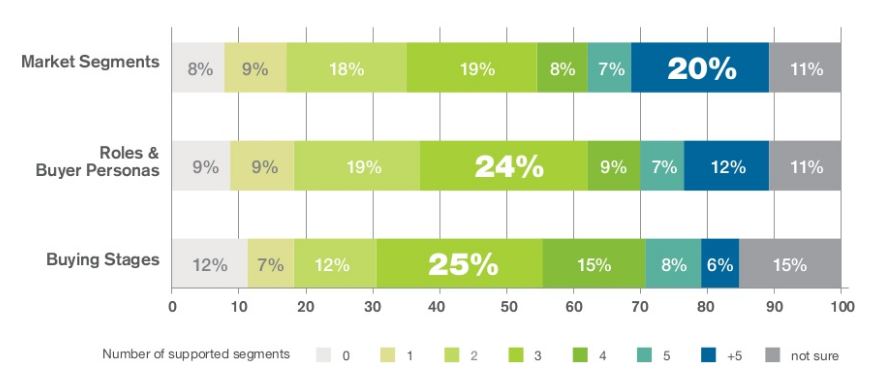
Takeaway: Prospects move through multiple stages as they get closer to becoming customers. Since the B2B buying process is long, it’s smart to create content in categories that generate leads, convert free users, and educate existing customers. Get educated on the different B2B buying stages here.
#40) About 49% of marketers are learning to drive content to align with the buyer’s journey – LookBookHQ
Takeaway: As content becomes more aligned with the buyer’s journey (and the different needs at each stage of that process) marketing teams are becoming better at creating content for sales enablement. This boosts the ROI of content and can be an extremely powerful tactic when sales and marketing teams work together.
#41) 80% of business decision makers prefer to get company information in a series of articles versus an advertisement. – Stratabeat
Takeaway: As we saw earlier, the trend of dislike towards ads continues amongst readership and decision makers–which is why more and more content teams are turning to blog posts and email drip campaigns to nurture their leads and grab new customers instead of ads.
With automation making this simpler than ever before, now is the time to consider different means of advertising to your target audience.
#42) 40% of companies have either “moderately” or “fully” integrated their marketing and sales automation systems. – Curata
Takeaway: Marketing tech stacks are becoming more important as teams pull together multiple resources to deliver relevant, personalized marketing assets to their audiences.
Now is the time to start thinking about what tools are currently missing from your marketing and sales automation efforts so you can start the new year on the right foot.
#43) 94% of B2B marketers use LinkedIn as part of their content strategy. Other popular platforms include Twitter (87%), Facebook (84%), YouTube (74%) and Google+ (62%). – Content Marketing Institute
Takeaway: For B2B companies, LinkedIn is the most widely used platform for content distribution–which makes sense, as this is a network for professionals.
For groups that have active conversations happening daily and a publishing platform built in, LinkedIn is a great place to start if you’re just beginning to use social media as part of your content marketing plan.
Interactive Content Statistics
#44) 53% of content marketers use interactive content – Content Marketing Institute
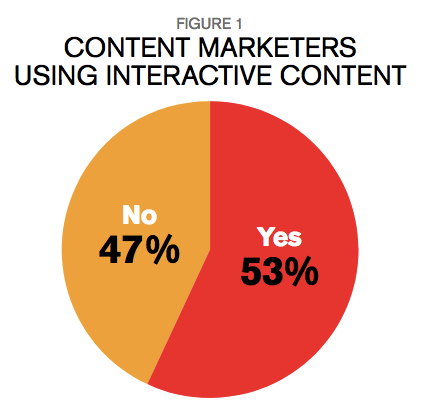
Takeaway: Instead of reading an article or passively consuming some form of video content, interactive content gives the user an opportunity to make choices, impact the outcome, and get involved with your business. Breaking down that barrier to participation improves ROI, engagement, dwell time, and other important metrics.
#45) Interactive content generates 2x more conversions than passive content – Kapost
Takeaway: Plodding through a blog post or browsing a PDF isn’t a particularly engaging activity. In fact, you could boost conversions by 200% by using interactive content like polls, calculators, quizzes, and assessments. If the user is already clicking and engaging with your content, they’re more likely to convert, too.
Get inspired by these 28 examples of interactive B2B content.
#46) 88% of marketers say interactive content helps them stand out from the competition – Business2Community
Takeaway: If you’re known for exciting interactive content, it automatically puts you a step ahead of the competition. That’s not the only upside to interactive content — businesses using the tactic also report higher pageviews, better engagement, and a more educated audience.
Even though creating things like quizzes and assessments sounds like a lot of work, you can use SnapApp to make the process painless.
#47) 93% said interactive content is somewhat or very effective at educating the buyer, compared to 70% for static content – Inc
Takeaway: It’s no surprise interactive content is better for buyer education than passive methods like blog posts and ebooks; studies into the way humans learn have proven engaged learners remember more of what they have been taught.
Engage your audience in the product education process by providing fun and useful interactive content.
#48) 91% of B2B buyers prefer to consume interactive and visual content – DemandGen
Takeaway: Are the days of static articles and plain PDFs coming to an end? Probably not any time soon, but we can be certain buyers are starting to prefer interactive and visual content. Include images, videos and polls in your content to improve engagement and educate your buyers.
Content Budget Statistics
#49) 92% of marketers said their organization views content as a business asset – Content Marketing Institute
Takeaway: Almost every marketer surveyed in the 2017 CMI Content Management & Strategy Survey said they see content as an area of business that deserves investment, and are tracking the goals and returns.
The fact just 46% of businesses have a solid plan for content proves there’s a big opportunity gap in the market.
Start building your strategy now to get ahead while you still can.
#50) 51% of B2B marketers will increase content marketing spending in the next 12 months. – Content Marketing Institute/MarketingProfs

Takeaway: Over half of businesses are pouring more money into content — even the 57% of marketers that aren’t seeing effective results are increasing their content budget.
This stat, and many others in this article point to one course of action: double down on content marketing.
#51) The most effective B2B marketers spend 39% of their marketing budgets on content – Content Marketing Institute
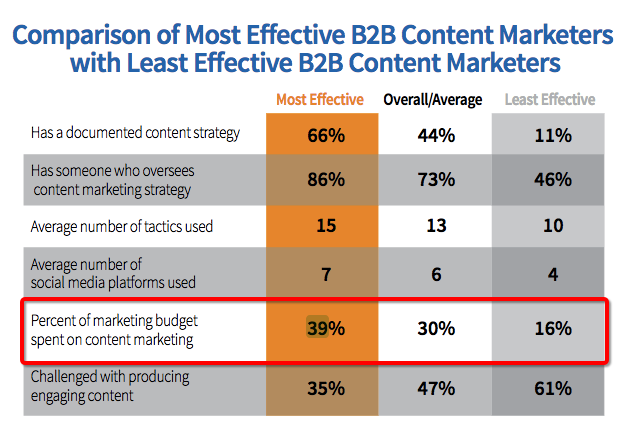
Takeaway: Surprise! The companies putting more money into content marketing also get better returns. The same companies are likely to have a solid content strategy, use a wider range of tactics, and find the creation of engaging content less challenging.
We already know most B2B companies are increasing PPC spend and seeing positive ROI from content marketing, so consider upping the budget this year.
#52) The marketing technology market is expected to grow to more than $32.3 billion in 2018 with a compound annual growth rate (CAGR) of 12.4% – IDC
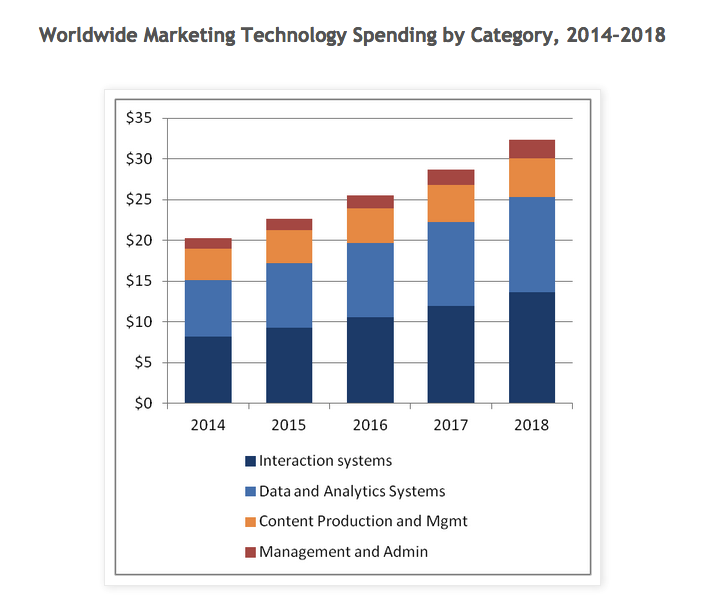
Takeaway: There’s an increased demand for marketing technology because it’s proven to work. As marketing makes a dramatic shift from analog to digital, businesses are investing heavily in tools to measure and manage every aspect of their content marketing strategy.
#53) Brands spend 25%-43% of their marketing budget on content, yet only 23% of CMOs feel they are producing the right information for the right audience, and delivering it at the right time and correct format. -Business2Community
Takeaway: Strategy, benchmarks, and clear objectives are necessary for teams who want to see their content efforts pay off. Be sure you have proper metrics in place to ensure your content marketing is doing everything it should do.
#54) 28% of marketers have reduced their advertising budget to fund more digital marketing. – Gartner
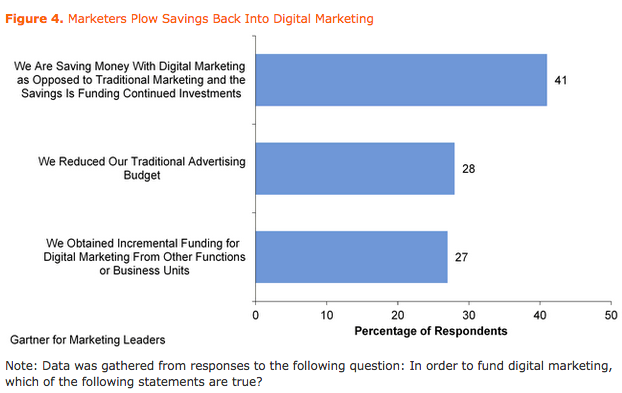
Takeaway: Digital marketing continually proves to be successful in a way that traditional advertising simply isn’t–and thanks to the advanced metrics that digital channels can provide, content marketing teams can make more informed future decisions with the digital medium. Now may be the time to rethink your budgets for next year.
Enter 2018 Prepared
Keep these stats in mind as you and your team considers the best plan of action for 2018–and get prepared with an intelligent strategy.
When content marketing is executed effectively, your organization benefits…so don’t wait to brainstorm what will work best for the year ahead. Start now.
Source: SnapApp


